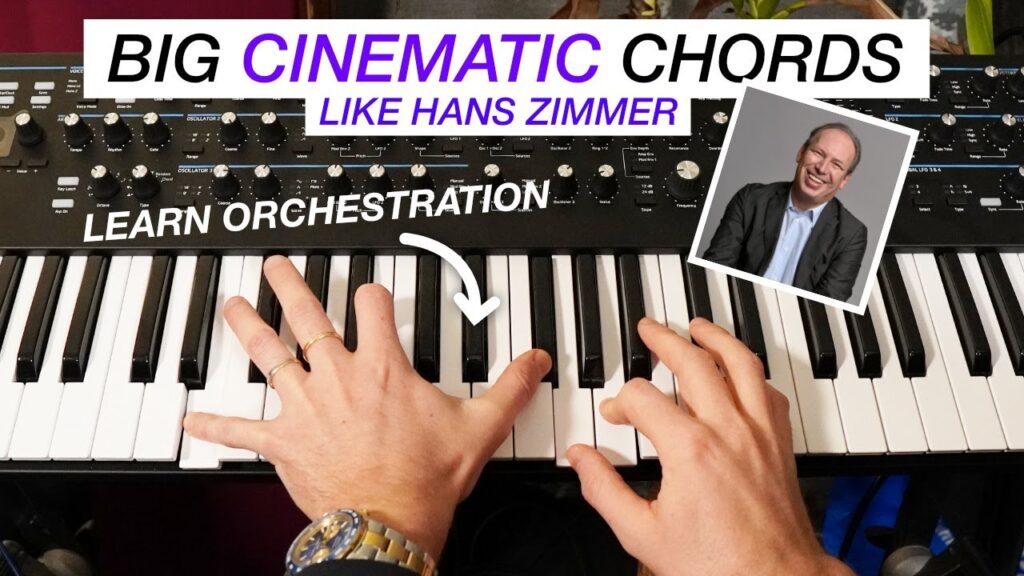Today I will teach you how to make those big cinematic chords like Hans Zimmer. You will learn about orchestrating chord notes from a very basic piano progression. Learn how to beef up those small triad chords into wonderful, dramatic and epic scores like the big guys over in Hollywood. Enjoy the video below! Happy composing!
How to make cinematic chords like Hans Zimmer and the Hollywood composers
Tips for creating cinematic chords like Hans Zimmer
Here are a few tips for creating cinematic chords like Hans Zimmer:
- Use a wide range of chord types and inversions. Zimmer is known for his use of dissonant and unresolved chords, as well as his use of unconventional chord progressions.
- Experiment with layering different chord structures and voicings. Zimmer often uses multiple keyboard sounds stacked on top of each other to create a rich, full sound.
- Use orchestration to add depth and texture to your chords. Zimmer often incorporates a range of orchestral instruments into his chord structures, including strings, brass, and woodwinds.
- Consider the emotional impact of your chord choices. Zimmer’s music is known for its ability to evoke strong emotions, and the chords he uses play a big role in this.
- Don’t be afraid to break the rules. Zimmer is known for his experimental approach to composition, and he isn’t afraid to push the boundaries of traditional harmony.
How does chord inversions work?
Hans Zimmer often uses chord inversions to add interest and complexity to his chord progressions. Inverting a chord means rearranging the order of the notes in the chord so that a different note is in the bass. For example, a C major chord in root position (C-E-G) can be inverted by moving the C to the top of the chord, resulting in a first inversion chord (E-G-C).
Using inversions can give a chord progression a more voice-led or melodic feel, rather than just being a series of block chords. It can also create dissonance or tension by disrupting the expected harmonic movement. Zimmer often uses dissonant and unresolved chords in his music, and inverting the chords can be a useful way to create these effects.
Quick analysis of Hans Zimmer song TIME from the Inception movie soundtrack
“Time” is an instrumental track that features a repetitive, driving piano motif, accompanied by a soaring string section and pulsing electronic beats. The melody of the song is relatively simple, but the harmonization and chord progression are more complex. Zimmer often uses unconventional chord progressions and dissonant chords in his music, and this is definitely the case in “Time” as well.
The song also features a sense of forward momentum and a building intensity, which is often present in Zimmer’s music. This could be achieved through a variety of techniques, such as layering additional instruments or sounds over the course of the song, or increasing the tempo or dynamic range. Zimmer loves epic percussion and building songs from smaller rhythmic parts to larger intense sections.
A more advanced analysis of the song “Time” from Inception
“Time” has two sets with four harmonies each. The first is a set of four: iv, i, III (an argument can be made for IV/VII), VII. The second set is iv, VI, III, VII, a harmonic variation on the first.
The harmonic plan starts with a plagal sound going from iv to i, but ends up VII which acts as IV/iv, which is quite clever. By establishing a plagal sound in the ear, the harmonic progression doesn’t ever seem like it should end. Importantly, this is important both in that it helps your ear forgive that you’re hearing the same thing over and over again.
We could also percieve that this is depicting / reflecting the dream levels (Inception‘s score is full of fun little things like that).
Progressive layering during the course of a song
Every time the set of eight harmonies repeats, the orchestration grows. More instruments come in, the sound becomes broader, louder, and busier. This is really common in music, I guess we could call it “progressive layering” as it’s about adding layers as the song progresses.
















